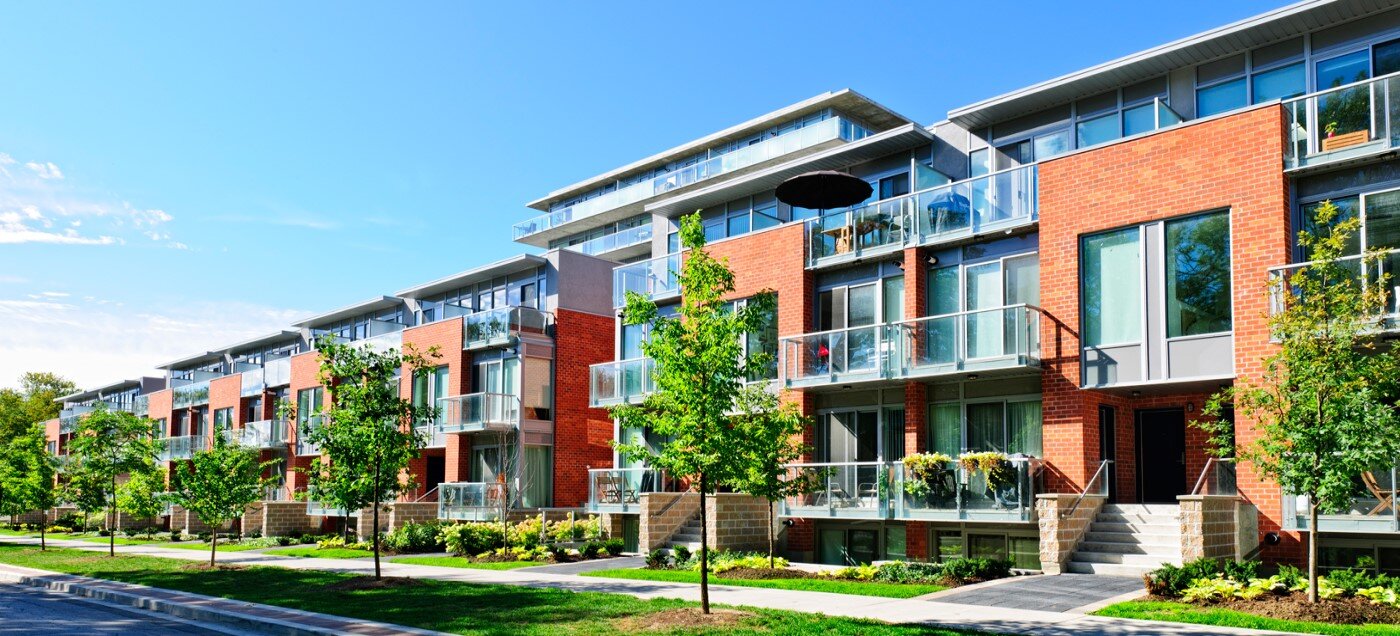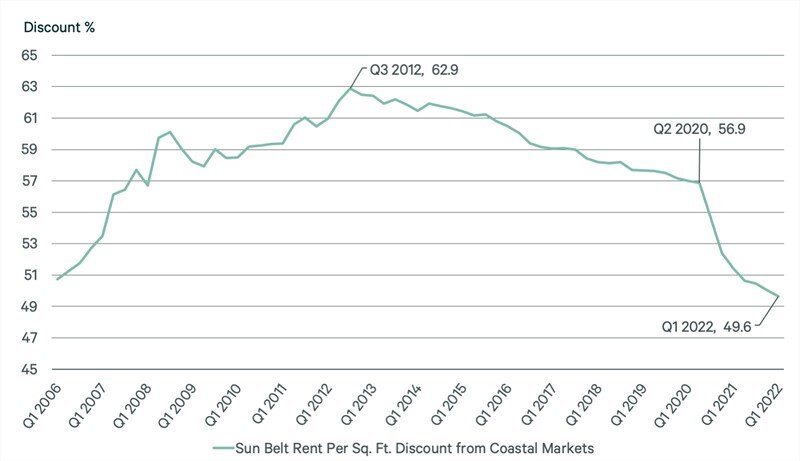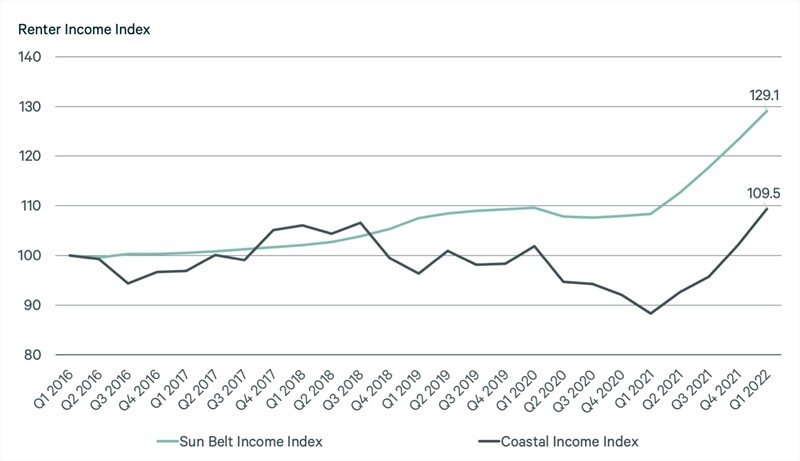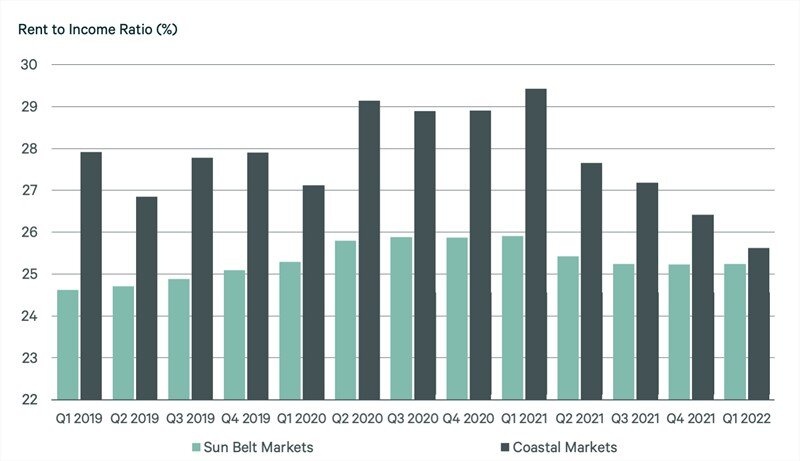Commercial Real Estate News

Sun Belt, Coastal U.S. Cities Multifamily Rent Gaps Narrow in 2022
Commercial News » Austin Edition | By Michael Gerrity | July 7, 2022 9:04 AM ET
According to global property consultant CBRE, Sun Belt markets have long offered cheaper multifamily rents on average than heavily populated coastal markets. However, the gap between the two has been narrowing since 2012, when the average Sun Belt apartment rent per sq. ft. was 63% lower than the average coastal market rent. Today, the average Sun Belt apartment rent is 24% higher than its pre-pandemic level in Q1 2020, compared with a 7% increase for the coastal market average. This has lowered the gap between the two to 50%, with more than half of this decline occurring over the past seven quarters due to pandemic-related in-migration creating more demand in lower-cost Sun Belt markets.
Despite the rent increase, Sun Belt markets remain relatively affordable because renter income1 has generally kept pace with the cost of rent. The average Sun Belt renter's income was 17.8% higher in Q1 2022 than the pre-pandemic level of Q1 2020, compared with just 7.5% higher for the average coastal renter income.
The rise in both income and rents has maintained a relatively consistent rent-to-income ratio of approximately 25% for Sun Belt markets during the pandemic. Renters are typically considered "cost burdened" if rent accounts for 30% or more of their gross household income. For coastal markets, when average renter income declined between Q1 2020 and Q1 2021, the average rent-to-income ratio initially came close to 30%. However, as income growth resumed in Q2 2021 alongside only moderate rental rate increases, coastal rent-to-income ratios fell more in line with Sun Belt ratios.
The pandemic has led to a more widely distributed workforce. Despite increased housing demand, rent and income growth, along with the supply response from developers, Sun Belt markets still have runway for additional rent growth before affordability becomes a pressing concern for the average renter.
Sign Up Free | The WPJ Weekly Newsletter
Relevant real estate news.
Actionable market intelligence.
Right to your inbox every week.
Real Estate Listings Showcase
Related News Stories
Commercial Real Estate Headlines
- One Trillion Dollars of America's Commercial Property Loans Mature in 2025
- U.S. West Coast Dominates Self Storage Demand
- Phoenix, Orange County and Inland Empire Emerge as Leading U.S. Industrial Markets
- U.S. Mega Distribution Centers Leasing Activity Grew in 2024
- U.S. Commercial Borrowing to Increase to $583 Billion in 2025, Up 16 Percent Annually
- Demand for U.S. Life Sciences Space Spikes 28 Percent Annually in Late 2024
- Multifamily Property Sector in America Rebounding
- Asia Pacific Commercial Property Investment Spikes 23 Percent in 2024
- U.S. Commercial Property Market Primed for Growth in 2025
- Architecture Industry Sees Mixed Signals as 2025 Approaches
- Global Data Center Demand Spikes in 2025
- 2025 Prediction: U.S. Commercial Investment Recovery Expected to Gain Traction
- Holiday Retail Sales for 2024 to Hit Record $1 Trillion
- Tech, AI Industries Drive Largest Share of Office Leasing Activity in U.S.
- Commercial Real Estate Lending in U.S. Enjoys Strong Growth in Q3
- U.S. Multifamily Market Begins Recovery in Q3
- Commercial Investment in Japan Spikes 24 Percent Annually in Q3
- Despite Return-to-Office Mandates, U.S. Office Vacancies Continue to Rise
- PROPSIG Tech Startup Acquired by World Property Data
- U.S. Commercial Mortgage Debt Hits $4.7 Trillion in Q2 as Delinquencies Increase
- Hong Kong Class A Office Rents Continue to Downtick in Mid-Summer
- U.S. Office Landlords Tenant Concessions Decline for First Time in 4 Years
- U.S. Commercial Mortgage Originations Spike 27 Percent in Q2 Over Q1
- Phnom Penh's Commercial Office, Retail Markets Face Slowdowns in 2024
- Global Edge Data Center Market to Hit $300 Billion by 2026
- Commercial Property Transactions in Japan Dive 25 Percent Annually in Q2
- Delinquency Rates for U.S. Commercial Property Loans Downticks in Q2
- Megawarehouse Lease Deals in U.S. Increase in 2024
- Office Tenants' Flight to Quality Buildings Increases in 2024
- Commercial Lending in Japan Upticks 6 Percent Annually in Q1
- AI Driving Significant Global Data Center Growth in 2024
- Total U.S. Commercial Mortgage Debt Rises to $4.7 Trillion in Q1
- U.S. Commercial Mortgage Delinquencies Rise in Early 2024
- Asia Pacific Office Sector to Further Reprice Throughout 2024
- U.S. Retail Foot Traffic to Surpass Pre-Pandemic Levels by 2025
- Commercial Real Estate Lending in U.S. Slowed in First Quarter
- Japan Commercial Property Investment Volume Jumps 7 Percent in Q1
- Asia Pacific Commercial Property Investment Leads the World, Spikes 13 Percent
- Driven by High Rates, U.S. Commercial Lending Imploded 47 Percent in 2023
- After Two Year Slump, Prime Multifamily Metrics Uptick in U.S.








